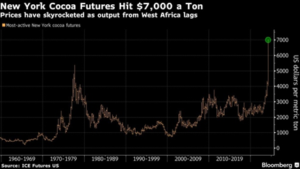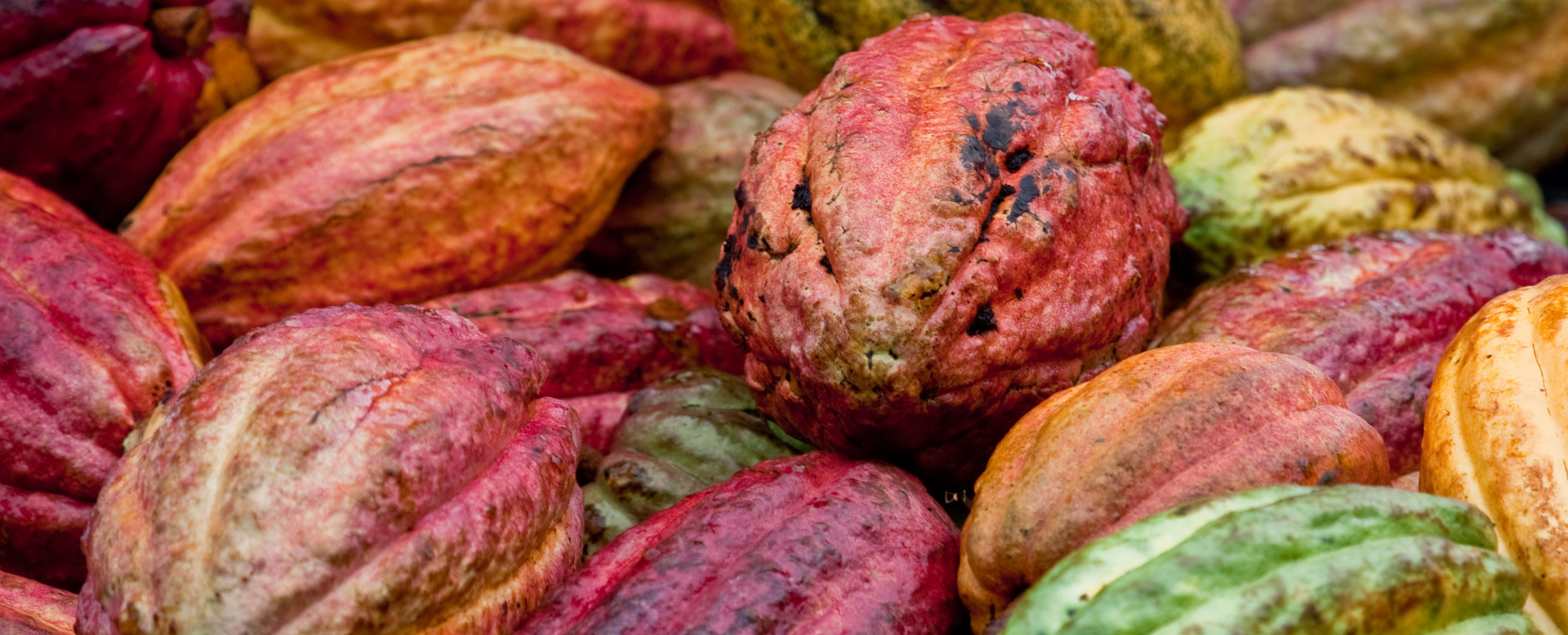Why is chocolate more expensive this year?
On World Chocolate Day, we discuss how the supply and demand of the cocoa is affecting the volatility of the global market
On World Chocolate Day, celebrated on July 7, we seek to understand how the cocoa production chain operates in the balance between supply and demand and how this is affecting market volatility.
Just to give you an idea, futures contracts for the commodity reached a new intraday record and exceeded US$ 11,000 in New York for the first time in April 2024. And the price of cocoa continues to be volatile on the international market.
To begin to understand the market, we explain how cocoa production works around the world:
The cocoa production chain?
Before it reaches the consumer as chocolate and other products, there is a whole process that begins with the cacao tree, the perennial plant from which the cacao fruit is extracted. There are basically three cultivated varieties:
- Forastero: this is the most common and accounts for up to 80% of world production. Its largest growing region is West Africa. Its main characteristics are its high yield, resistance to disease and bitter taste.
- Criollo: softer and of higher quality. It is less vigorous and more vulnerable to disease. Its main growing region is Venezuela.
- Trinitario: originated on the island of Trinidad, it was created by crossing Criollo and Forastero. The variety therefore combines the strength of bulk cocoa with the aromas of fine cocoa.
There are basically seven stages in the cocoa production chain. Below, we explain each of them.
1. Cultivation
The production unit (UP) or rural property begins to grow cocoa. This stage requires preparing the soil, which must be rich in organic matter and well-drained.
Cocoa trees are planted in suitably shady conditions, usually under taller trees to protect them from direct sunlight. During cultivation, farmers monitor the trees to ensure that they receive enough water and are free from pests and diseases.
2. Harvesting
Cocoa is harvested by hand for 3-4 weeks, after which the beans germinate and regular picking is necessary. Farmers open the fruit and remove the wet beans within a week to 10 days of harvesting.
3. Fermentation
After harvesting, the cocoa beans are split open. The seeds, known as cocoa beans, are removed and placed in boxes or mounds to ferment. This process can last from a few days to a week, depending on local conditions.
Fermentation creates the characteristic flavors of cocoa by removing undesirable substances and developing compounds that contribute to the taste of chocolate.
4. Drying
After fermentation, the cocoa beans are spread out in the sun to dry. This process can take several days and is essential to reduce the moisture content of the beans, which helps prevent mold during storage.
The cocoa beans are turned regularly to ensure even drying and prevent mold from forming. When the beans have reached the ideal moisture content, they are packaged and sent for further processing, such as roasting and grinding, to produce chocolate.
5. Negotiation
The next step in the process can vary. Farmers have several options: they can transport, classify and export their grain directly; sell to an intermediary; or join a cooperative that handles sales to the exporter. Regardless of the method chosen, the grain is inspected, sorted and sent to a warehouse near the port.
6. Transportation
Once sorted, the grains are prepared for shipment on cargo ships. They can be shipped in jute bags or in bulk. Bulk transportation can be done in containers or without packaging.
7.Roasting and milling
Cocoa beans are roasted to reduce their water content and develop aromas and flavors. This can be done before hulling the whole beans or after they have been hulled. After roasting and hulling, the beans are ground at high temperatures to form a fine cocoa liquor, which can be used directly as a culinary ingredient. The cocoa liquor can be pressed through a fine sieve, separating it into solid material (cocoa cake) and a purer liquid/cream (cocoa butter). The cake can be broken into smaller pieces and welded, or pulverized into a powder with varying fat content.
What factors explain the volatility in cocoa prices?
There are specific factors that justify the volatility currently affecting the cocoa market, as they have a direct impact on West Africa. This is where the world’s two largest producers are concentrated: Ivory Coast and Ghana.
Below, we explain each of the aspects that have influenced production in this region.
● Weather
Cocoa is climate-dependent because weather conditions directly affect its growth and development. Consistent and moderate temperatures, combined with adequate humidity, are essential for the flowering, fruiting and ripening of cocoa fruits. This crop is particularly vulnerable to water scarcity, requiring between 1,500 mm and 2,000 mm of rain annually for optimal development. Dry periods, with less than 100 mm of rain for more than three months, can significantly reduce productivity. During the fruit bud development phase, especially in the middle of the harvest, factors such as the Harmattan and the dry season play a crucial role.
In addition, regular rainfall is crucial to ensuring an adequate supply of water for cocoa trees. This promotes healthy growth and fruit production.
The harmattan, a phenomenon of dry winds and dust that rises from the Sahara, has made the climate drier in Ivory Coast and Ghana. El Niño also changed temperatures and reduced rainfall in some regions, which reduced productivity in the last cycle.
● Agricultural pests
Cocoa plantations can suffer from the presence of agricultural pests such as:
- Witches’ broom (Moniliophthora perniciosa): this is one of the most devastating cocoa diseases. It is caused by a fungus that infects the buds, flowers and fruit of the cocoa plant, which leads to the death of the infected parts and a reduction in production.
- Brown rot (Phytophthora spp.): a disease caused by various types of fungi of the genus Phytophthora, which infect the cocoa fruit. This results in decay and loss of quality and quantity of production.
- Myrtle (Atta spp.): these leaf-cutting ants can cause significant damage to cocoa plantations. As a result, they weaken plants and reduce production.
- Cocoa bean borer (Conopomorpha cramerella): a pest that affects cocoa fruits by piercing them to feed on the seeds. This can result in significant damage to the quality and quantity of production.
- Cicadas (Empoasca spp.): sap-sucking insects that can cause damage to cocoa leaves, weakening plants and reducing production capacity.
Today, however, the pest that most affects cocoa is the swollen bud virus. This is a serious disease that interferes with cocoa plantations. It causes swelling in the buds and deformities in the leaves, with significant damage to production.
● Lack of pesticides
Ghana is expected to produce 40% below the target for the season. The swollen bud virus is contributing to this, along with the late application of pesticides and fungicides to protect the cocoa trees.
In order to reduce costs, the Ghanaian government has gradually decreased the distribution of cocoa seedlings and pesticides to almost a million farmers. Instead, the government paid farmers a higher price for cocoa and let them buy the equipment and services. However, many farmers pocketed the extra money from the government.
When the government found out, it went back to delivering the chemicals directly. But it was too late for the crop to grow.
● High demand
Demand for cocoa remains high, despite record prices. The ICCO (International Cocoa Organization) predicts that consumption will exceed production by 38,000 tons of cocoa beans by 2024.
The main explanations for this resilience lie in increased demand from emerging markets in Asia and also in changing consumer habits. The population is not giving up small luxuries such as chocolate, a trend that began during the COVID-19 pandemic.
Is the rise in cocoa prices in 2024 a Black Swan event?
A black swan is any unpredictable event that has a major impact on the entire economy. In other words, events that are out of the ordinary and have global repercussions.
The philosopher Nassim Taleb introduced this concept and determined a classification for events that considerably affect the financial market. The logic behind the study is that we live in an unstable world. In this sense, it is essential to prepare to manage risks.
And that’s what happened in the cocoa market in 2024. Due to the problems in African plantations, there was what we might call a black swan. After all, the impacts were significant and intense in relation to the commodity’s prices, which skyrocketed all over the planet and continue to trend upwards.
Cocoa futures in New York reach US$7,000 a tonne


Source: Bloomberg
Read also: General outlook for agricultural and energy commodities in 2024
- Volatility in the commodities market: outlook for 2024
Hedgepoint: hedging products for the cocoa market
The cocoa market suffered a so-called black swan event. In other words, production of the commodity was impacted, which continues to affect the entire globe.
In this sense, market participants must adopt instruments to protect themselves from volatility. After all, risks will always exist. Hedgepoint provides commodity hedging products, such as the use of derivatives, to fix the price of cocoa in relation to buying and selling in the future.






